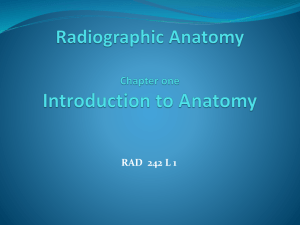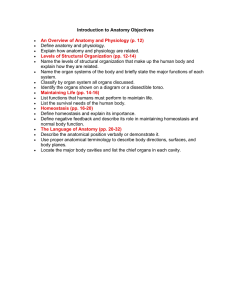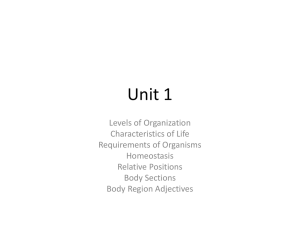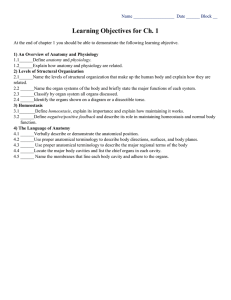Briefing Paper No. 2 Julie Palmer and Frances Griffiths
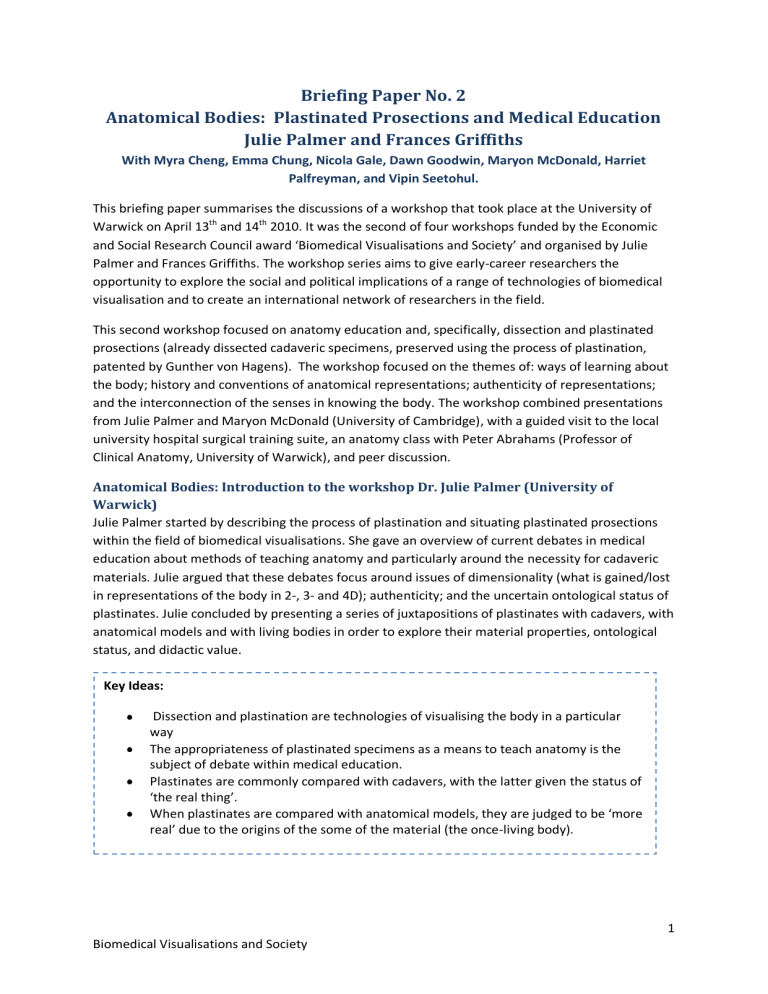
Briefing Paper No. 2
Anatomical Bodies: Plastinated Prosections and Medical Education
Julie Palmer and Frances Griffiths
With Myra Cheng, Emma Chung, Nicola Gale, Dawn Goodwin, Maryon McDonald, Harriet
Palfreyman, and Vipin Seetohul.
This briefing paper summarises the discussions of a workshop that took place at the University of
Warwick on April 13 th
and 14 th
2010. It was the second of four workshops funded by the Economic and Social Research Council award ‘Biomedical Visualisations and Society’ and organised by Julie
Palmer and Frances Griffiths. The workshop series aims to give early-career researchers the opportunity to explore the social and political implications of a range of technologies of biomedical visualisation and to create an international network of researchers in the field.
This second workshop focused on anatomy education and, specifically, dissection and plastinated prosections (already dissected cadaveric specimens, preserved using the process of plastination, patented by Gunther von Hagens). The workshop focused on the themes of: ways of learning about the body; history and conventions of anatomical representations; authenticity of representations; and the interconnection of the senses in knowing the body. The workshop combined presentations from Julie Palmer and Maryon McDonald (University of Cambridge), with a guided visit to the local university hospital surgical training suite, an anatomy class with Peter Abrahams (Professor of
Clinical Anatomy, University of Warwick), and peer discussion.
Anatomical Bodies: Introduction to the workshop Dr. Julie Palmer (University of
Warwick)
Julie Palmer started by describing the process of plastination and situating plastinated prosections within the field of biomedical visualisations. She gave an overview of current debates in medical education about methods of teaching anatomy and particularly around the necessity for cadaveric materials. Julie argued that these debates focus around issues of dimensionality (what is gained/lost in representations of the body in 2-, 3- and 4D); authenticity; and the uncertain ontological status of plastinates. Julie concluded by presenting a series of juxtapositions of plastinates with cadavers, with anatomical models and with living bodies in order to explore their material properties, ontological status, and didactic value.
Key Ideas:
Dissection and plastination are technologies of visualising the body in a particular way
The appropriateness of plastinated specimens as a means to teach anatomy is the subject of debate within medical education.
Plastinates are commonly compared with cadavers, with the latter given the status of
‘the real thing’.
When plastinates are compared with anatomical models, they are judged to be ‘more real’ due to the origins of the some of the material (the once-living body).
1
Biomedical Visualisations and Society
Anatomy Class at University Hospital Coventry and Warwickshire with Professor Peter
Abrahams (Professor of Clinical Anatomy, Warwick Medical School).
Attendees participated in an anatomy class lead by Peter Abrahams. They viewed a selection of plastinated specimens from throughout the body and received tuition about the structures of the body. Participants were simultaneously learning basic anatomy and having the experience of learning anatomy using plastinates. This provided material for reflection in other parts of the workshop.
Key Ideas:
Learning anatomy entails a complex process of compiling information from 2D representations (anatomy atlas), 3D specimens, and relating this to the living body.
Plastinated specimens have authenticity as cadaveric material but their dry and odourless materiality sometimes make it difficult to remember their ontological status as human tissue.
The anatomy lab is in a discrete location which feels very private, and has procedures in place to ensure respectful behaviour and professionalism.
‘If my mother could see me now…’ The articulation of bodies and cadavers in anatomical dissection classes. Dr. Maryon McDonald (Department of Social Anthropology, University of Cambridge)
Maryon McDonald started with an historical overview and by arguing that different conventions of medical representation reflected changing notions of objectivity, as well as a shift from dissection as public spectacle to medical education. Within medical education, the three-dimensional materiality of the body is difficult to learn, and further problems are posed by the ‘ontological instability’ of the body. The body within medicine is always multiple (e.g. the anatomical body is distinguishable from the surgical body from the cellular body). Maryon focussed on her ethnographic fieldwork in dissection rooms in UK universities. She argued that the process of studying anatomy can trouble familiar body boundaries, boundaries that are historically and socially constituted, and reconstituted in all kinds of medical processes. In learning anatomy, students must ‘acquire’ a new body, just as a perfumier acquires a ‘nose’ (Latour), in order to make the distinctions and categorisations necessary for an anatomist, as well as learning detachment. The cadaver must be transformed into an anatomical body, although there are moments with the personhood of the body re-emerges (e.g. the sight of a tattoo or a catheter) and personhood is deliberately re-emphasised at the memorial service at the end of the academic year.
Key Ideas:
Methods of teaching anatomy have never been uncontroversial.
Anatomical study involves the troubling of familiar boundaries and social transgressions.
Conventions of anatomical representation shift with notions of objectivity.
Bodies are acquired in practice, and in interaction with the environment.
Cadavers must be shaped into anatomical bodies.
2
Biomedical Visualisations and Society
Discussion
Discussion was wide ranging. We started by discussing tactility and the place of touch and kinaesthetics within anatomy learning. The difficulty of representing the flexibility or elasticity of some body parts and tissues was raised. The question of how much tactile knowledge is needed in order to practice different kinds of medicine was raised. The historical specificity of ways of perceiving the body was discussed and the capacity of models, diagrams and other representations to shape how we see the body. We reflected on our own curiosity about how the process of plastination changes and shapes the specimen. Discussion moved on to issues around anatomical diversity and the contrast between standardised models (or carefully selected bodies) and the diversity of the human body and potential patient. Finally, the working practices around anatomy were discussed, from the ethics and practicalities of body donation programmes to propriety in the dissection room, and memorial services for donated bodies. The tensions between cadavers as work objects and moments when personhood re-emerges were explored.
Suggested directions for further research:
Comparative studies of medical ways of knowing the body (e.g. osteopath, surgeon, alternative medicine practitioner).
How are the different senses implicated in learning anatomy? (e.g. how is sound used to
‘visualise’ the body)
How do lay people perceive anatomical images and how do we incorporate these into our understanding of bodies?
How do diagrams represent the body? What changing metaphors have been employed?
(e.g. body as factory, brain as a telephone exchange)
Biomedical Visualisations and Society
3

